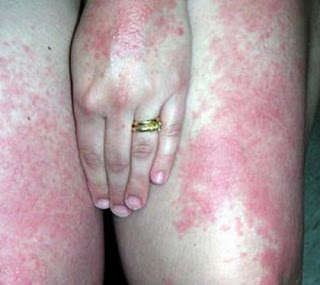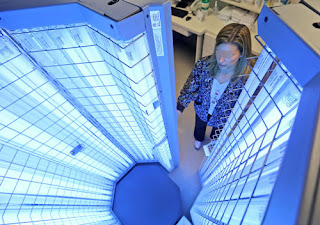Sun Rash Pictures
A sun rash also known as sun allergy is the immune system's reaction to the damaging rays of the sun. The rash is characterized by itchy red bumps, which typically affects the exposed parts of the body particularly the neck, arms, back of the hands, and lower legs.
A severe sun rash could cause hives and blister formation, which can spread to the body parts that are not exposed to the sun. (1, 2, and 3)
References
A severe sun rash could cause hives and blister formation, which can spread to the body parts that are not exposed to the sun. (1, 2, and 3)
picture 1: A mild rash caused by exposure to the sun.
image source: hswstatic.com
picture 2: A moderate sun rash on the patient's skin.
image source: bioresonance-ibiza.com
picture 3: A polymorphous light eruption rash on the patient's thighs and hand.
image source: medscapestatic.com
picture 4: Actinic prurigo on the patient's face.
image source: dermquest.com
picture 5: A rash secondary to photoallergic reaction.
image source: medicinenet.com
picture 6: A solar urticaria rash.
image source:wikimedia.org
What causes sun rash?
A sun rash is a result of the changes in the skin when it is exposed to the heat of the sun. Some components of the sun are perceived by the immune system as foreign material thereby forming an allergic reaction in the form of rashes and blister formation. However, this reaction does not occur to all people. It only happens to people who are hypersensitive to the rays of the sun. (2, 3, and 4)A rash from sun is grouped into different categories. They are the following:
- Polymorphous light eruption (PMLE) - The skin exposed to the sun becomes itchy and filled with rashes. This type of sun rash is more common in women than men and it at its peak during summer and spring. During the first two hours of sun exposure, the patient experiences severe itching and burning sensation, especially in areas exposed to the sun such as arms, lower legs, neck, and upper chest.The patient also complains of headache and nausea. How long does sun rash last? If you avoid exposure to the sun, the rashes will soon be gone, usually within three days' time. (3, 4, and 5)
- Actinic prurigo - The symptoms are more severe than that of the polymorphous light eruption. The rashes are more concentrated on the face, especially around the lips. It commonly affects the American Indian population. (5, 6)
- Photo allergic reaction - It is a rash from sunscreen. The rays of the sun reacts to the chemicals of the sunscreen causing an allergic reaction. Aside from sunscreen, other things that can trigger an allergic reaction when exposed to extreme heat of the sun include cosmetics, antibiotic ointment, and even fragrances. The rashes are red and itchy and sometimes tiny blisters are formed.The rashes do not instantly occur after sun exposure. It usually takes two days before the rashes are formed. (4, 5, and 6)
- Solar urticaria - The sun rash on hands and other parts of the body exposed to the sun have large, itchy, red bumps also known as hives. It commonly affects young women. (2, 3, 10)
Sun rash treatment
How to get rid of sun rash? What is the available treatment for sun rash? The treatment approach varies depending on the severity of the symptoms. (5, 6, and 7)
picture 7: Sun rash should be cold compressed to alleviate pain and swelling.
image source: newhealthguide.org
picture 8: A phototherapy is one of the advanced medical approach for sun rash.
image source : townnews.com
Mild sun rash
- Cold compress helps alleviate the pain and discomfort.
- You can also use non-prescription antihistamine to somehow relieve itching and discomfort.
- Use over-the-counter cream containing cortisone to relieve itching and alleviate inflammation.(6, 7, and 8)
Moderate to severe rash
- For severe sun rash, the doctor might recommend using phototherapy. It gradually exposes the skin to ultraviolet light so that it will be immune to light exposure.
- A prescription strength corticosteroid and antihistamine can be prescribed too. (7, 8, and 9)
Emergency situation
You should call out for help if you experience any of the following:
- A severely inflamed and itchy rash that does not respond to over-the-counter treatments.
- If the rashes cover a huge area of the body.
- If the rashes bleed.
- If the hives appear along with swelling of the eyes, lips, difficulty swallowing, and difficulty breathing. (6, 8, 9, and 10)
- https://www.mayoclinic.org/diseases-conditions/polymorphous-light-eruption/expert-answers/sun-rash/faq-20058163
- https://www.health.harvard.edu/allergies/sun-allergy-photosensitivity
- http://www.netdoctor.co.uk/conditions/skin-and-hair/a3620/sun-rash-solar-dermatitis/
- https://www.washingtonpost.com/national/health-science/summer-heat-and-sun-can-give-you-a-rash-heres-what-to-do/2014/07/28/7bbafc00-11a8-11e4-9285-4243a40ddc97_story.html?utm_term=.c591998101ec
- https://www.medicinenet.com/heat_rash/article.htm
- https://www.refinery29.com/sun-allergies
- https://health.howstuffworks.com/skin-care/beauty/sun-care/5-things-about-sun-rash.htm
- http://www.listentoyourgut.com/symptoms/53/sun-rash-solar-dermatitis.html
- https://www.healthline.com/health/sun-poisoning
- https://www.onhealth.com/content/1/heat_rash









